
Our first introduction to the ritual is from a boat on the river in Varanasi.
Looking towards the “stage” we see the seven platforms for the priests, each topped with a canopy of brightly coloured fairy lights.
We move in closer and the ceremony begins with priests chanting the age-old Vedic Sanskrit chants, or bhajans, that bless the river, symbolically bowing to this supreme source of life.
The river is the Ganges, regarded throughout India as a goddess, and an important deity in the Hindu pantheon. The ceremony is Ganga Aarti, a nightly ritual to honour, pray to, and give thanks to this holiest of rivers, Maa Ganga, the Divine Mother who gives life to all.
The Aarti, a ritual to dispel darkness, is more than 2000 years old, and every evening at sunset Ganga Aarti takes place in four towns along the Ganges – Varanasi, Allahabad, Haridwar, and Rishikesh. The ceremony is so beautiful, and so compelling that Don and I go three times in Varanasi (once from the boat, and twice on shore), once in Haridwar, and three times in Rishikesh.
Come with me and see the magic of it:
In Varanasi the crowds gather and we are welcomed like family.
Assistants light the candles
while the priests prepare their platforms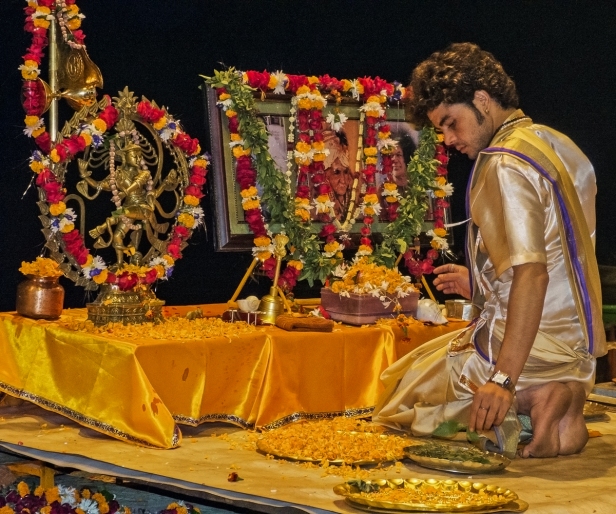
and then wait in position.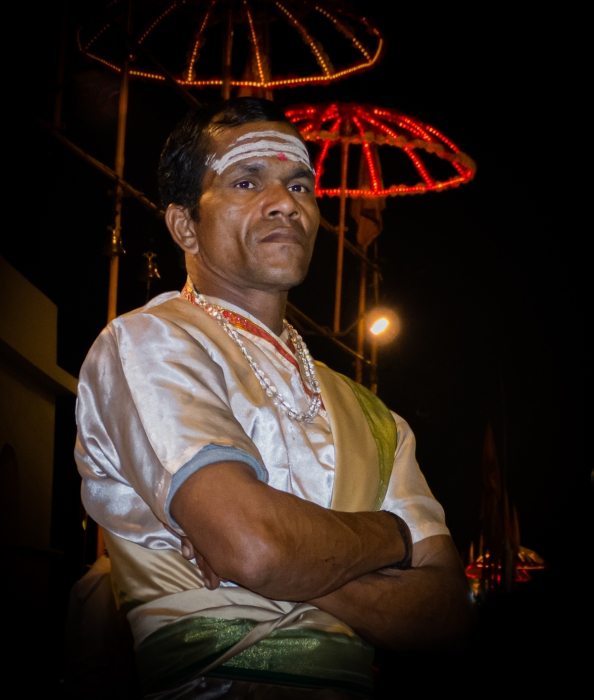
It begins with a loud blast on a conch shell, followed by live music that continues throughout the entire ceremony: harmonium, flutes, drums and cymbals, chanting and singing, all played over loudspeakers so the whole crowd can hear. And the bells! Always the bells! It’s a joyous harmonious cacophony loud enough for even the gods to hear.
The priests move in stylised choreographed movements closely matched to the rhythmic chants of the hymns and the clanging of the cymbals. First they raise sticks of incense and with great deliberation wave them in clockwise and then in counter-clockwise circles as they face each direction in turn, all the while ringing hand-held bells. Strings are held by congregation members who pull on them to ring the bells that are attached to the canopies.
The sticks of incense are followed by bowls of smoking camphor to purify the soul.
A bowl in one hand and a bell in the other, the bowls are held high and waved in circles, again facing all four directions.
This same ritual continues. A bowl of burning camphor, then a candelabrum of burning candles to bring light to the darkness,
a feathery yak tail, followed by a peacock feather fan. The priests are earnest and focused.
With practiced movements and deep reverence they wave each object in the air in circles to the joyous and insistent soundscape of chanting, singing, music and bell ringing. Randomly, and with great authority, the conch shell sounds to help set you free from your sins. The aroma of sandalwood fills the air.
The evening Ganga Aarti is somewhat equivalent to the Muslim call to prayer, except the Aarti lasts for about 40 minutes. Just as the Muslim call to prayer can come from multiple sources, in Rishikesh the Aarti comes from three separate places – Triveni ghat, Shatrughna Temple Ghat, and Parmarth Niketan Ashram. We are in Rishikesh for a month in February 2019, and again in 2020. Both times our hotel faces the river and the music of the Aarti comes from all directions but the loudest and clearest by far is that which soars to us directly across the river from Parmarth Niketan.
Every evening at sunset we are serenaded by the bells and singing of Sanskrit devotional prayers.
We don’t go to Rishikesh’s Triveni Ghat where the major Aarti takes place. Instead we go across the river to Parmarth Niketan, the biggest ashram in the town. Each evening hundreds come to this uplifting transcendent ritual. We join the crowd and find a seat on the steps close to the water as the Brahmin students of the ashram, in their red sweaters and saffron robes, begin their preparations.
“Aarti at Parmarth Niketan is organized and performed by ashram residents, particularly the children who are studying the Vedas there. The ceremony commences with the singing of bhajans, prayers, and a purifying and sacred ritual that takes place around a fire, with the offerings made to Agni, the fire god.
The lamps are lit and the Aarti takes place as the final part of the ceremony. The children sing along with the spiritual head of the ashram, in sweet, haunting voices.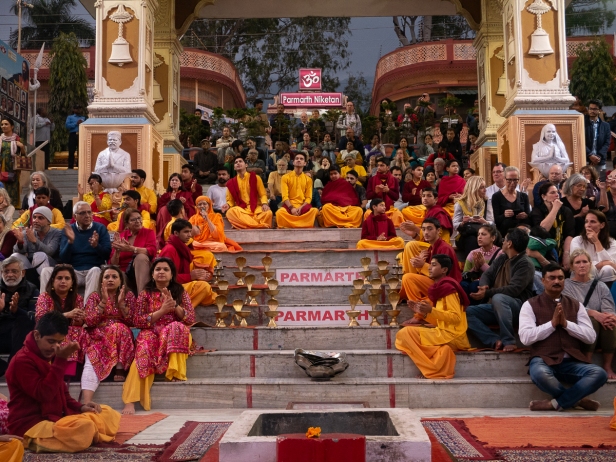
A huge statue of Lord Shiva overlooks the proceedings.”
The ceremony at Varanasi is a highly stylised and choreographed ritual. At Parmarth Niketan it is more inclusive and many bowls of burning camphor are handed out for people in the crowd to hold them as the chanting continues.
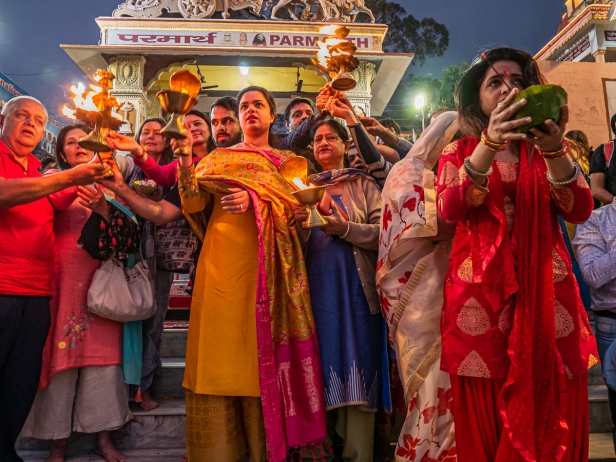
Towards the end we all rise and sway to the soaring music. There is a palpable sense of the divine, and, regardless of the ability to understand the chants, the power of the ritual is universal, transcending boundaries of language and culture. It goes straight to the heart. The music and colour alone are enough to lift your spirits. There is a sense of joy and unity as people move down to offer their flower pujas to the river.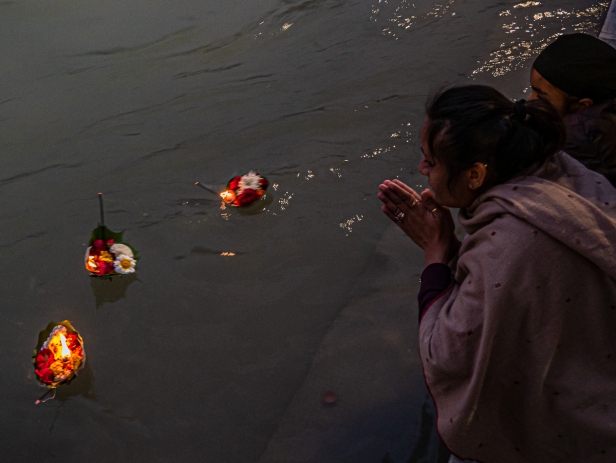
*****************
I find it by following the sound. From our balcony I can hear that there is a Ganga Aarti ceremony somewhere close to our hotel, and sure enough I find it a five-minute walk away on Shatrughna Temple Ghat.
We get there early, almost before anyone else has arrived.


The platforms are ready, the speaker system is set up, and the priests and officials are doing their final preparations. We are asked to remove our shoes before entering the area.
This Aarti is similar to Varanasi, where the priests enact the same choreographed ritual, each on their own platform facing the river. There is a good crowd but not huge like Varanasi and Parmarth Niketan, and there’s an informal friendly ambience. 

The holy ritual begins, echoing the same movements as the dance in Varanasi. The flaming bowls and candelabra are raised high as the sunset-sky fills with colour and then gradually darkens.

Every object is symbolic, and every movement. The music and singing resound throughout it all, a 40-minute Hindu hallelujah. As the night descends it is believed that the Goddess Ganga showers her blessings on all present, and all present give their thanks and devotion to Maa Ganga.
The end comes when the priests empty their bowls of Ganga water back into the river.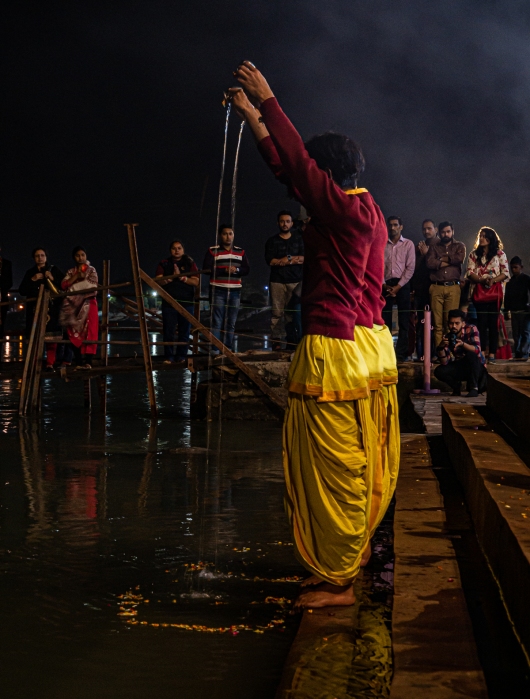
When all is finally over what could possibly be more Indian than a cow wandering into the scene?
Ganga Aarti in Haridwar couldn’t be more different and yet it is just as captivating. We do a day trip from Rishikesh in March of 2019 and stay for the Aarti, finding a place to sit with the crowd on a small island in the river.
Performed on Har Ki Pauri Ghat, the Haridwar Aarti is a spiritual pageant where thousands of people, priests, and idols are sandwiched into a relatively small space. As with the other ceremonies there are loudspeakers, clanging bells, singing, incense, flowers, and fire, and I can only imagine how compelling it would have been to be part of that crowd.
Watching from across the water we see the priests gather as the idol of the River Ganga is brought from a nearby temple to a platform on the ghat. There is chanting, and call and response from the congregation as they raise their hands.
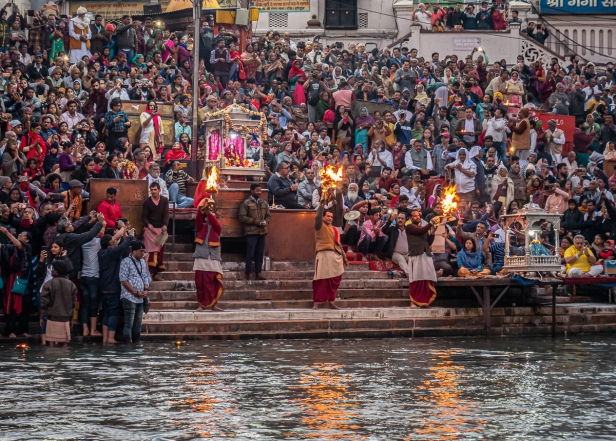

Although there is not the stylised choreography of Varanasi or Shatrughna Temple Ghat in Rishikesh, the devotion is the same, the music is the same, the bhajans and prayers are the same.
In 2020 we return to Ganga Aarti at Shatrughna Ghat in Rishikesh. The priests have new robes, but the energy, the beauty, and the music are eternal. And in the background the lights of Ram Jhula dance on the water.

According to the Hindu religion God gives us light all day – the light of the sun, the light of life. Ganga Aarti, held when darkness descends, is when we give that light back in the form of love and devotion. It is a time to forget the stresses of the day and gather together in joy, reverence, and harmony.
************************
The Ganga Aarti song in Haridwar: (6 minutes)
Varanasi (7 minutes)
Shatrughna Ghat, Rishikesh (6 minutes)
All words and images by Alison Louise Armstrong unless otherwise noted
© Alison Louise Armstrong and Adventures in Wonderland – a pilgrimage of the heart, 2010-2020.

Wow!
Thanks for putting this series of images together and sharing 🙂
LikeLiked by 1 person
My pleasure! Glad you enjoyed it. It’s really quite an amazing ceremony.
Alison
LikeLiked by 1 person
Welcomed like family I can see in the gaze of many of the people…and I know you love the culture and all the offerings…and the cow wandering through making it magical…always appreciate your narratives Alison…amazing adventure appreciate you sharing…all new to me ☺️🤓smiles Hedy
LikeLiked by 2 people
Thank you so much Hedy. Indian people are so welcoming. Everywhere we went it was the same, and for this especially. Everyone is welcomed and included.
The cow was priceless! So perfect.
Going to Ganga Aarti was really special. I’m glad it made you smile.
Alison 🙂
LikeLiked by 1 person
It’s a perfect post Alison 💫💛
LikeLiked by 1 person
This is a great post. Gorgeous photos, Alison, and I love that you included the music.
LikeLiked by 1 person
Thanks so much Kay. Just had to include the music – so rich and beautiful, and we’d hear it every evening and it immediately calmed me and I’d start to hum along.
Alison
LikeLike
Wow, the beauty of this tradition! I feel like I’ve been transported through your words and images. That you and Don went to experience Ganga Aarti so many times in numerous places speaks to its feeling and beauty. So wonderful that you were openly welcomed ~ Indian hospitality is so gracious and inviting toward those unfamiliar with the many traditions and ceremonies. Community is clear in your photos and this daily ritual makes me yearn for it even more. Thanks for the hope woven throughout your story, Alison.
LikeLiked by 2 people
Thanks Kelly. Transported is good. It is indeed a truly beautiful ceremony. You can’t help but be moved by it. And yes, Indian hospitality at its best; every time people would move a little to make a spot for us to sit. We really felt like part of the community especially in Varanasi and Rishikesh. This ceremony brought out the best in everyone and everyone left feeling uplifted.
Alison
LikeLiked by 1 person
ALL the best things about travel!!
LikeLiked by 1 person
Yes!
LikeLiked by 1 person
Faith overwriting all. Brilliant Alison.
LikeLiked by 1 person
Thanks so much Cindy. There is such deep faith and devotion in India. The culture seems steeped in it, and it’s definitely one of the reasons I love it so much.
Alison
LikeLike
Beautiful. I belong to Allahabd, born and bought up, moving to Delhi after marriage. Sangam was our playgroud every summer sundays. I have been to Varanasi (innumerable times), Hardwar and Rishikesh but somehow missed the Ganga Aartis. Hopefully someday
LikeLiked by 2 people
Thank you so much. You’ve been to all the places! I do hope you get back one day to one of them for Ganga Aarti. It’s really special. I think I’d recommend Varanasi though I’ve heard it’s changed a bit since we were there and is a bit more touristy now.
Alison
LikeLiked by 1 person
Varanasi is upposed to be cleaner now.
LikeLiked by 1 person
These photos are beyond breathtaking, Alison. Marvellous piece of respectful reportage.
LikeLiked by 1 person
Aaaah Thank you Tish. It feels lovely to hear you say all of that. The ceremony is so special that I wanted to share the realness and beauty of it.
Alison
LikeLiked by 1 person
what an amazing and beautiful ritual. your photos and explanations are so interesting and helped me to learn about this, something i was completely unaware of. thank you
LikeLiked by 1 person
Thanks so much Beth. My pleasure. It really is a special ceremony. So much beauty and love and sharing. Everyone is uplifted by it.
Alison
LikeLiked by 1 person
How amazing that must have been to witness. The pictures certainly give us a good idea. Every culture has amazing events like this but some just know how to do it better! Great memories for you too. Hope you are both doing OK. xo
LikeLiked by 2 people
It really was amazing! We always try to find the local festivals and ceremonies, and definitely the Indians do it well. So much colour and heart!
We’re fine thanks. Hope you are too.
Alison xo
LikeLiked by 1 person
Glad to hear you are OK. All is good here in our corner of Spain.
LikeLiked by 1 person
Very beautifully captured through colourful images and detailed narrative, dear Alison. Instead of blindly worshipping an unseen god, it makes eminent sense to worship a gigantic manifestation of Nature that Ganga truly is. Can there be a more meaningful tribute to the environment?
LikeLiked by 2 people
Thank you so much. I’m glad you enjoyed it. And yes I agree, it makes so much sense to worship nature, and the Aarti is a most beautiful and meaningful tribute. We’d probably all be better off if there had been a lot more nature worship, or at least plain respect, over the past fifty years or so.
Alison
LikeLike
Listening to the the Ganga Aarti song brought your words and photos together for me, Alison. Quite beautiful. The spirituality really comes through. Thank you. –Curt
LikeLiked by 1 person
Thanks Curt. My pleasure. I’ve had this post on the back burner for quite a while now, and I’m so glad I finally got it done.
I think I could listen to that song all day and not get tired of it. It’s seems to help my soul rest. And I guess that’s as good a definition as any of spirituality.
Alison
LikeLike
To be at peace!
LikeLiked by 1 person
Yes, that too.
LikeLiked by 1 person
Fantastic post and spectacular photos!
LikeLiked by 1 person
Thank you so much. Every time we went it was a wonderful experience so it feels good to finally share it.
Alison
LikeLike
Incredible photos, Alison. No wonder you take in the ceremony so often. It’s like all is infused with a roaring bronze sun.
LikeLiked by 2 people
Thanks so much Julie. A roaring bronze sun – brilliant description! So yes the photography was quite exciting. But also infused with heart, and joy. So we kept going back for more 🙂
Alison
LikeLiked by 1 person
Thank you dear Alison,Your wonderful photos of Aarti on the Ganges took me back to my delight whenever I’ve attended the ceremonies at the ghat in Varanasi. I never have attended an Aarti in Rishikesh or Hariwar so appreciate your descriptions and photos of ceremonies there. Beautifully written and presented to us, 🙏🏾❤️
LikeLiked by 1 person
Thank you so much Linda. So having been to Ganga Aarti in Varanasi you know just what I’m talking about – the music, the bhajans,the priests performance, the mood! It’s all so uplifting. My faves are Varanasi and Shatrughna Ghat in Rishikesh. I guess I like the more stylized version.
We must do a social distancing picnic soon!
Alison xo
LikeLike
How beautiful. We also went many times to this ceremony when we were in Varanasi. But I’ve learned much more about it here, than I knew then. I love your last paragraph about light and life.
LikeLiked by 2 people
Thanks Tracey. It’s such a beautiful ceremony. For sure I’ll go again if we’re ever back in that part of India. I think Varanasi is my fave.
Alison
LikeLike
All said and done, Ganga Aarti is best in Varanasi. No other place, Rishikesh or Haridwar comes close. I have seen all of them. Been to Varanasi in December so that memory is vivid. Thank you for this post. I relived the divine event once again.
LikeLiked by 1 person
My pleasure. I’m so glad it transported you back there. I agree that Varanasi is the best . . . but . . . I saw a video online where they’d totally tarted up the performance since we were there in 2012 – added a second layer of platforms and a whole bunch of “maidens” standing around in colourful saris. It felt as if the people were an “audience” and somewhat distanced from the “performance”, rather than a congregation at a sacred ceremony. Maybe the video I saw was just for some big festival or something. It’s from 2016. Anyway I was disappointed, and compared to that I loved the simplicity of Shatrughna Temple Ghat in Rishikesh.
Alison
LikeLiked by 1 person
I guess that video might have depicted some special ceremony. It wasn’t like that at all this December. Rather, it was just as you describe it. 🙂
LikeLiked by 1 person
Oh I’m so glad to hear that! I really loved it at Varanasi. As you said – the best!
A.
LikeLiked by 1 person
Alison, this post transported us right back to Pushkar at the time of the camel fair. We spent way more time listening to and watching the Aarti’s than at the festivities of the fair. Thank you for the great memories. Your photographs are amazing and really do capture the spirit of the Aarti. Particularly interesting to see the different venues, sizes and formality. All seem way more formal and better organized than what we witnssed in Pushkar.
Interesting the comparison with the competing calls to prayer from mosques which we experienced in Flores in Indonesia and as well in Morocco.
Really great to see your beautiful photos and read about these ancestral rituals of our former neighborhood of South Asia.
Peta & Ben
LikeLiked by 2 people
Thank you so much. I’m glad you enjoyed my post. I’ve been sitting on it for a while, not sure I could do justice to it. Transported is good. I only went once in Pushkar and didn’t really pay that much attention. I was too taken up with everything else going on, but in Varanasi (my first introduction to it) it’s such a show that you couldn’t miss it.
Every evening I was in Rishikesh the Aarti would come from three directions and it was like the call to prayer we’d heard in Turkey – coming from all directions. Both are beautiful traditions, but I must admit the Aarti speaks to me, and of course is much more of a show. So beautiful to watch and be included in the energy.
Hope all is well with you guys in Mexico.
Alison
LikeLike
Great story telling with your photography!
LikeLiked by 1 person
Thank you so much! Glad you enjoyed it.
Alison
LikeLike
I really like to read about your travels and see your beautiful photos.
LikeLiked by 1 person
Thanks so much rabirius. I’m so glad you’re enjoying the blog.
Alison
LikeLike
Every evening? I had to go back and re-read this to make sure I got it right. What a beautiful ceremony and you have captured it so exquisitely in your amazing words and photos. We have decided to add Varanasi to our India itinerary but I fear that this trip may not be in the cards for 2020. It’s wonderful though to keep my anticipation high with posts like yours.
LikeLiked by 2 people
Thank you so much Caroline. It really is a beautiful ceremony, and yes, held every night (though admittedly I never went out to check in a downpour). Do add Varanasi! It’s our favourite Indian city, with Rishikesh a close second. Hope you get there one day.
Alison
LikeLiked by 1 person
We always experience this as outsiders. I often wonder what it must be like to be born into the religion and it be a part of our life. It seems so entrusting. Childlike even. Maybe my lack of real faith makes it seem so. An amazing and affecting spectacle, I’m very sure.
LikeLiked by 2 people
I love the colour, and devotion, and yes, the trust of it. The feeling is palpable when you’re there, this kind of joyous surrender. But, yes, I agree. Religions simply ask you to trust. It’s not for me, never has been, but then I was born into a family of atheists so have no clue what it would be like to be raised in a household of unwavering faith. This trust, or faith seems to run deep in India, and of course there are many reasons for that.
Alison
LikeLiked by 1 person
Excellent❣️ Thank you for sharing this ceremony with us in this way, your photography is amazing, transporting me right into the scene. This us so different to anything I’m familiar with. Awesome.
Best wishes to you both from Norfolk, stay safe and keep well. X
LikeLiked by 1 person
Thank you so much. Transported is good. I love the festivals and ceremonies in India – so rich, colourful and heartfelt.
We’re safe and well thanks. Hope you are too.
Alison
LikeLike
What a spectacle made all the more dramatic by being celebrated at night. But my favorites scenes here were the intimate photos of the platforms with flower petals and incense, and the cow wandering into the scene. Thank you for sharing!
LikeLiked by 1 person
Thanks Lynn, my pleasure. It’s such a spectacular ceremony. I loved getting there early enough to get those shots of the platforms and incense just as the light was starting to change. And the cow! You couldn’t have scripted that!
Alison
LikeLike
I’m finally getting around to catching up on your posts. The world–Japan, Borneo, India, tulips in Canada–feels so indulgent, so extravagant, after being in this covid-bubble for nearly 3 months. Wanderlust…
We somehow missed the aarti in Rishikesh, but our experience of it in Haridwar was not good. I wish we’d watched it from your vantage point. Instead, we were in the thick of it with a couple of priests who pressured us mercilessly to give more money than we were comfortable giving. It might have just been another lesson learned, but we (my sons and I) were offering our pujas for my late husband, their father. Having it turn into a priest fleecing was painful for us. In Varanasi it was an equally colorful spectacle, but no greedy priests in sight. We did our own personal puja without intervention. It was sweet and healing. Love Varanasi.
LikeLiked by 1 person
Hi Jane! Yes, the world does feel indulgent, extravagant, or actually more non-existent. We’re contained here in a safe bubble but that feeling of just taking off at any time doesn’t even arise. The world out there is not as it was/not available/simply gone. I don’t think I’ve come to terms with that yet.
Your experience in Haridwar sounds dreadful. I’d heard people could be pressured to contribute, but that sounds beyond the pale. So sad for you. But so wonderful you were able to have a good experience in Varanasi. Of all those we went to Varanasi is the best I think, followed by the smaller one in Rishikesh.
Alison
LikeLike
Dear Alison, you’ve captured our spirutual Indian culture / tradition so beautifully by this captivating read and photos of the “eternal spiritual pageant” of Ganga Aarti. Being an Indian, visiting Varanasu has been in my bucket list, and your blog gas given me all the more reason to visit Ganga Maa…thank you, Pranaam🙏🏼
May Ganga Maa bless you too!
LikeLiked by 1 person
Thank you so much Leena. I so much appreciate hearing that I’ve managed to capture the feeling and the spirituality of Ganga Aarti. It’s such a beautiful ceremony.
I hope you get to Varanasi! I think the Aarti there is the best of the four we’ve been to. Plus we’ve been to many places in India and Varanasi is my favourite!
Blessings
Alison
LikeLike
Wonderful photos, Alison! The dance, the smoke, and the fire… they all look mystical. At first, I thought they are performing cremation. But when I read your text, I know it is a totally different ritual 🙂
LikeLiked by 1 person
Thank you so much Len 🙏 It is a really mystical ceremony, and I’m glad we got to see so many versions of it. Definitely the Varanasi ritual is the best, but the others are all powerful in their own right. We did also get to see cremations in Varanasi – that was a whole other extraordinary experience.
Alison
LikeLike